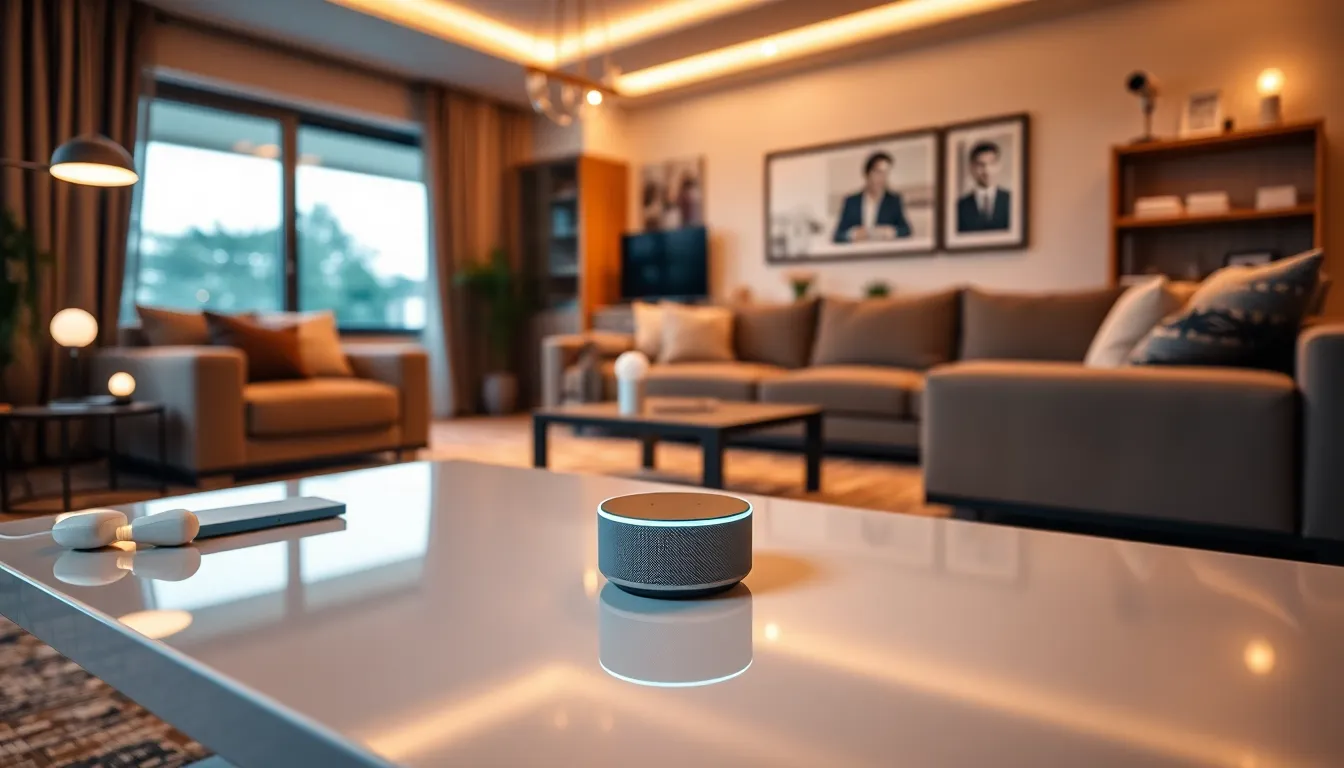Table of Contents
ToggleImagine a world where you can control your home with just your voice. No more fumbling for remotes or getting up from the couch to adjust the lights. Enter the voice command hub—a tech-savvy sidekick that transforms everyday living into a seamless experience. It’s like having a personal assistant who never takes a coffee break and is always ready to help, even if it can’t fetch your snacks.
Overview of Voice Command Hubs
Voice command hubs serve as central units for smart home management. These devices allow users to interact verbally with various connected systems. Efficiency defines their operation, as users can execute commands without physical input.
Convenience becomes evident when considering how many devices can integrate with a voice command hub. Lights, thermostats, and entertainment systems connect seamlessly. Popular platforms like Amazon Alexa, Google Assistant, and Apple HomeKit lead in this space. Users experience the benefits of advanced voice recognition technologies.
Accessing information is straightforward with these hubs. Users can ask for weather updates, traffic reports, or control household appliances effortlessly. Voice command hubs often deploy artificial intelligence, evolving to understand context better. Real-time updates enhance user interaction, ensuring that commands receive prompt attention.
Interoperability plays a crucial role in the functionality of these devices. They support various protocols, such as Zigbee and Z-Wave, ensuring compatibility with numerous smart devices. Installation remains user-friendly, requiring minimal technical knowledge.
Security features are essential for user trust. Most voice command hubs offer encryption to safeguard personal data. Regular software updates maintain defenses against potential vulnerabilities. Overall, voice command hubs represent a significant advancement in smart home technology, simplifying how individuals manage their living spaces.
Features of Voice Command Hubs

Voice command hubs boast several key features that enhance their functionality and user experience.
User Interface
Intuitive interfaces allow users to interact seamlessly with their hubs. Touchscreens, buttons, and voice prompts often provide multiple ways to control features. Voice control takes precedence, allowing hands-free interaction for convenience. Feedback through visual cues and tones enhances user understanding. Easy navigation ensures users can access settings without hassle.
Compatibility with Devices
Compatibility with a wide range of devices stands as one of the most significant advantages. Popular platforms like Amazon Alexa, Google Assistant, and Apple HomeKit support numerous smart devices, from light bulbs to security cameras. Users can connect items from various manufacturers without issues. Integration with different protocols, including Zigbee and Z-Wave, delivers additional flexibility. This interoperability promotes a cohesive smart home ecosystem.
Voice Recognition Capabilities
Advanced voice recognition capabilities define the effectiveness of voice command hubs. Machine learning algorithms enhance understanding of natural speech patterns. Hubs learn user preferences over time, enabling personalized responses. Multi-language support caters to diverse user groups, creating wider accessibility. Accurate processing of contextual commands allows for efficient execution of tasks.
Popular Voice Command Hubs on the Market
Voice command hubs dominate the smart home market by providing seamless integration and user-friendly interfaces. Here are some of the most popular options available today:
Hub A Review
Hub A stands out for its excellent compatibility across a wide range of smart devices. Advanced voice recognition technology enables efficient control over numerous household appliances. Users appreciate its intuitive interface, simplifying navigation for all family members. This hub supports popular protocols like Zigbee, enhancing its ability to connect with various devices. Security features, such as end-to-end encryption, ensure user data remains protected against vulnerabilities.
Hub B Review
Hub B excels in smart home automation with robust AI capabilities. Personalized responses and proactive suggestions define the user experience, making daily tasks more manageable. Voice command accuracy is among the best in its class, which ensures a smooth interaction. This hub offers integration with entertainment systems, enabling effortless media control. Regular software updates maintain its performance and introduce new features, keeping it relevant in a rapidly evolving technological landscape.
Hub C Review
Hub C is known for its multi-language support, catering to diverse households. Its sleek design combines functionality with aesthetics, appealing to many users. Voice activation works seamlessly, allowing hands-free control of various connected devices. The device adapts quickly to user preferences, providing a customized experience. With compatibility across leading smart home brands, it fosters a cohesive environment for users looking to streamline their home management.
Advantages of Using a Voice Command Hub
Voice command hubs enhance home automation, offering users significant benefits. One major advantage is convenience; users execute tasks using simple voice commands, eliminating manual adjustments. Smart home integration stands out, as these hubs connect and control various devices such as lights, thermostats, and entertainment systems.
Speed also improves productivity. Quick access to information, including weather updates and traffic reports, transforms daily routines. Advanced AI capabilities enhance context understanding, allowing for more accurate and personalized responses.
Accessibility increases for users with disabilities, as voice commands provide an efficient means of controlling devices. User-friendly interfaces, including touchscreens and prompt features, further promote ease of interaction.
Data security becomes a priority with robust encryption methods and regular software updates. Users remain confident in their personal data protection, ensuring trust in the device and company.
Versatility shines through, as compatibility with numerous smart devices encourages a cohesive smart home ecosystem. These hubs often support various protocols like Zigbee and Z-Wave, simplifying the integration of different manufacturers’ products.
Voice recognition technology continues to advance, improving task execution accuracy. Continuous learning algorithms adapt to user preferences over time, creating a more tailored experience. Voice command hubs deliver significant advantages, revolutionizing how individuals manage their home environments.
Voice command hubs are revolutionizing the way individuals interact with their homes. By offering effortless control over various devices through simple voice commands, they enhance convenience and efficiency in daily routines. As these hubs continue to evolve with advanced technologies, their ability to integrate seamlessly with multiple smart devices ensures a cohesive and user-friendly experience.
The benefits extend beyond mere convenience, as they also promote accessibility and security. With robust data protection measures and intuitive interfaces, voice command hubs are becoming essential components of modern living. As users embrace this technology, they’ll find that managing their home environment has never been easier or more secure.







